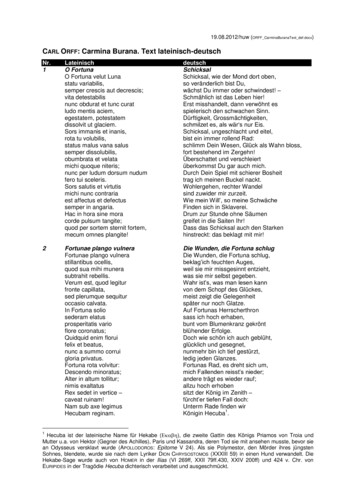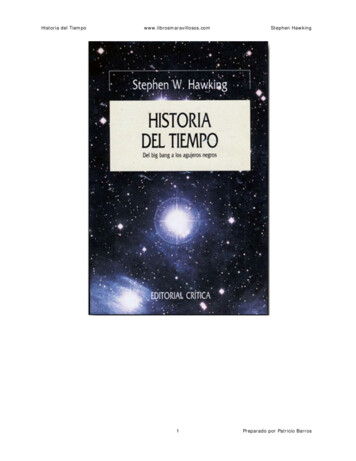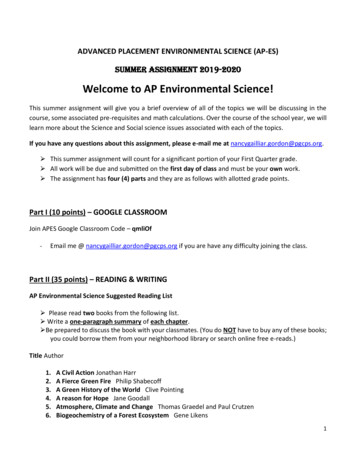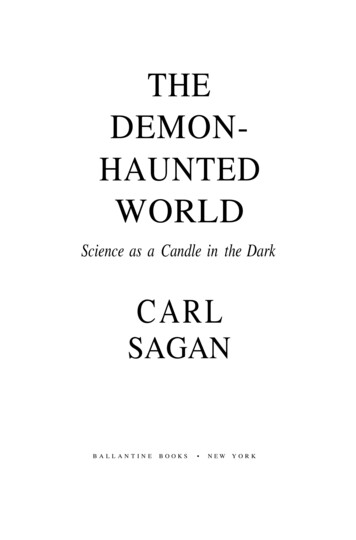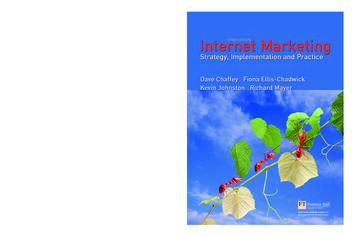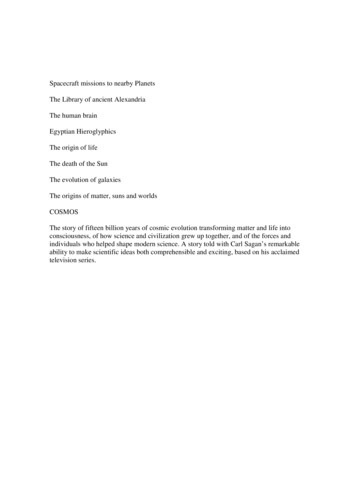
Transcription
Spacecraft missions to nearby PlanetsThe Library of ancient AlexandriaThe human brainEgyptian HieroglyphicsThe origin of lifeThe death of the SunThe evolution of galaxiesThe origins of matter, suns and worldsCOSMOSThe story of fifteen billion years of cosmic evolution transforming matter and life intoconsciousness, of how science and civilization grew up together, and of the forces andindividuals who helped shape modern science. A story told with Carl Sagan’s remarkableability to make scientific ideas both comprehensible and exciting, based on his acclaimedtelevision series.
For Ann DruyanIn the vastness of space and the immensity of time,
it is my joy to sharea planet and an epoch with Annie
Carl Sagan was the Director of the Laboratory for Planetary studies and David DuncanProfessor of Astronomy and Space Sciences at Cornell University. He played a leading rolein the Mariner, Viking and Voyager expeditions to the planets, for which he received theNASA medals for Exceptional Scientific Achievement and for Distinguished PublicService, and the international astronautics prize, the Prix Galabert.He served as Chairman of the Division for Planetary Sciences of the AmericanAstronomical Society, as Chairman of the Astronomy Section of the American Associationfor the Advancement of Science, and as President of the Planetology Section of theAmerican Geophysical Union. For twelve years, he was Editor-in-Chief of Icarus, theleading professional journal devoted to planetary research. In addition to four hundredpublished scientific and popular articles, Dr Sagan was the author, co-author or editor ofmore than a dozen books, including Intelligent Life in the Universe, The CosmicConnection, The Dragons of Eden, Murmurs of Earth, Broca’s Brain and the bestsellingscience fiction novel, Contact.He was a recipient of the Joseph Priestly Award ‘for distinguished contributions to thewelfare of mankind’, and the Pulitzer Prize for literature.Carl Sagan died in December 1996.
CARL SAGANCosmosCONTENTSIntroduction1The Shores of the Cosmic Ocean2One Voice in the Cosmic Fugue3The Harmony of Worlds4Heaven and Hell5Blues for a Red Planet6Travelers’ Tales7The Backbone of Night8Travels in Space and Time9The Lives of the Stars10The Edge of Forever11The Persistence of Memory12Encyclopaedia Galactica13Who Speaks for Earth?Appendix 1: Reductio ad Absurdum and the Square Root of TwoAppendix 2: The Five Pythagorean Solids
INTRODUCTIONThe time will come when diligent research over long periods will bring to light thingswhich now lie hidden. A single lifetime, even though entirely devoted to the sky, would notbe enough for the investigation of so vast a subject . . . And so this knowledge will beunfolded only through long successive ages. There will come a time when our descendantswill be amazed that we did not know things that are so plain to them . . . Many discoveriesare reserved for ages still to come, when memory of us will have been effaced. Ouruniverse is a sorry little affair unless it has in it something for every age to investigate . . .Nature does not reveal her mysteries once and for all.- Seneca, Natural Questions,Book 7, first centuryIn ancient times, in everyday speech and custom, the most mundane happenings wereconnected with the grandest cosmic events. A charming example is an incantation againstthe worm which the Assyrians of 1000 B.C. imagined to cause toothaches. It begins withthe origin of the universe and ends with a cure for toothache:After Anu had created the heaven,And the heaven had created the earth,And the earth had created the rivers,And the rivers had created the canals,And the canals had created the morass,And the morass had created the worm,The worm went before Shamash, weeping,His tears flowing before Ea:‘What wilt thou give me for my food,What wilt thou give me for my drink?’‘I will give thee the dried figAnd the apricot.’‘What are these to me? The dried figAnd the apricot!Lift me up, and among the teethAnd the gums let me dwell! . .Because thou hast said this, O worm,May Ea smite thee with the might ofHis hand!(Incantation against toothache.)Its treatment: Second-grade beer . . . and oil thou shalt mix together;The incantation thou shalt recite three times thereon and shalt put the medicine uponthe tooth.
Our ancestors were eager to understand the world but had not quite stumbled uponthe method. They imagined a small, quaint, tidy universe in which the dominant forceswere gods like Anu, Ea, and Shamash. In that universe humans played an important if not acentral role. We were intimately bound up with the rest of nature. The treatment oftoothache with second-rate beer was tied to the deepest cosmological mysteries.Today we have discovered a powerful and elegant way to understand the universe, amethod called science; it has revealed to us a universe so ancient and so vast that humanaffairs seem at first sight to be of little consequence. We have grown distant from theCosmos. It has seemed remote and irrelevant to everyday concerns. But science has foundnot only that the universe has a reeling and ecstatic grandeur, not only that it is accessibleto human understanding, but also that we are, in a very real and profound sense, a part ofthat Cosmos, born from it, our fate deeply connected with it. The most basic human eventsand the most trivial trace back to the universe and its origins. This book is devoted to theexploration of that cosmic perspective.In the summer and fall of 1976, as a member of the Viking Lander Imaging FlightTeam, I was engaged, with a hundred of my scientific colleagues, in the exploration of theplanet Mars. For the first time in human history we had landed two space vehicles on thesurface of another world. The results, described more fully in Chapter 5, were spectacular,the historical significance of the mission utterly apparent. And yet the general public waslearning almost nothing of these great happenings. The press was largely inattentive;television ignored the mission almost altogether. When it became clear that a definitiveanswer on whether there is life on Mars would not be forthcoming, interest dwindled stillfurther. There was little tolerance for ambiguity. When we found the sky of Mars to be akind of pinkish-yellow rather than the blue which had erroneously first been reported, theannouncement was greeted by a chorus of good-natured boos from the assembled reporters- they wanted Mars to be, even in this respect, like the Earth. They believed that theiraudiences would be progressively disinterested as Mars was revealed to be less and lesslike the Earth. And yet the Martian landscapes are staggering, the vistas breathtaking. I waspositive from my own experience that an enormous global interest exists in the explorationof the planets and in many kindred scientific topics - the origin of life, the Earth, and theCosmos, the search for extraterrestrial intelligence, our connection with the universe. And Iwas certain that this interest could be excited through that most powerful communicationsmedium, television.My feelings were shared by B. Gentry Lee, the Viking Data Analysis and MissionPlanning Director, a man of extraordinary organizational abilities. We decided, gamely, todo something about the problem ourselves. Lee proposed that we form a productioncompany devoted to the communication of science in an engaging and accessible way. Inthe following months we were approached on a number of projects. But by far the mostinteresting was an inquiry tendered by KCET, the Public Broadcasting Service’s outlet inLos Angeles. Eventually, we jointly agreed to produce a thirteen-part television seriesoriented toward astronomy but with a very broad human perspective. It was to be aimed atpopular audiences, to be visually and musically stunning, and to engage the heart as well asthe mind. We talked with underwriters, hired an executive producer, and found ourselvesembarked on a three-year project called Cosmos. At this writing it has an estimated
worldwide audience of 140 million people, or 3 percent of the human population of theplanet Earth. It is dedicated to the proposition that the public is far more intelligent than ithas generally been given credit for; that the deepest scientific questions on the nature andorigin of the world excite the interests and passions of enormous numbers of people. Thepresent epoch is a major crossroads for our civilization and perhaps for our species.Whatever road we take, our fate is indissolubly bound up with science. It is essential as amatter of simple survival for us to understand science. In addition, science is a delight;evolution has arranged that we take pleasure in understanding - those who understand aremore likely to survive. The Cosmos television series and this book represent a hopefulexperiment in communicating some of the ideas, methods and joys of science.The book and the television series evolved together. In some sense each is based onthe other. But books and television series have somewhat different audiences and admitdiffering approaches. One of the great virtues of a book is that it is possible for the reader toreturn repeatedly to obscure or difficult passages; this is only beginning to become possible,with the development of videotape and video-disc technology, for television. There is muchmore freedom for the author in choosing the range and depth of topics for a chapter in abook than for the procrustean fifty-eight minutes, thirty seconds of a noncommercialtelevision program. This book goes more deeply into many topics than does the televisionseries. There are topics discussed in the book which are not treated in the television seriesand vice versa. Explicit representations of the Cosmic Calendar, featured in the televisionseries, do not appear here - in part because the Cosmic Calendar is discussed in my bookThe Dragons of Eden; likewise, I do not here discuss the life of Robert Goddard in muchdetail, because there is a chapter in Broca’s Brain devoted to him. But each episode of thetelevision series follows fairly closely the corresponding chapter of this book; and I like tothink that the pleasure of each will be enhanced by reference to the other.For clarity, I have in a number of cases introduced an idea more than once - the firsttime lightly, and with deeper passes on subsequent appearances. This occurs, for example,in the introduction to cosmic objects in Chapter 1, which are examined in greater detaillater on; or in the discussion of mutations, enzymes and nucleic acids in Chapter 2. In a fewcases, concepts are presented out of historical order. For example, the ideas of the ancientGreek scientists are presented in Chapter 7, well after the discussion of Johannes Kepler inChapter 3. But I believe an appreciation of the Greeks can best be provided after we seewhat they barely missed achieving.Because science is inseparable from the rest of the human endeavor, it cannot bediscussed without making contact, sometimes glancing, sometimes head-on, with a numberof social, political, religious and philosophical issues. Even in the filming of a televisionseries on science, the worldwide devotion to military activities becomes intrusive.Simulating the exploration of Mars in the Mohave Desert with a full-scale version of theViking Lander, we were repeatedly interrupted by the United States Air Force, performingbombing runs in a nearby test range. In Alexandria, Egypt, from nine to eleven A.M. everymorning, our hotel was the subject of practice strafing runs by the Egyptian Air Force. InSamos, Greece, permission to film anywhere was withheld until the very last momentbecause of NATO maneuvers and what was clearly the construction of a warren ofunderground and hillside emplacements for artillery and tanks. In Czechoslovakia the use
of walkie-talkies for organizing the filming logistics on a rural road attracted the attentionof a Czech Air Force fighter, which circled overhead until reassured in Czech that no threatto national security was being perpetrated. In Greece, Egypt and Czechoslovakia our filmcrews were accompanied everywhere by agents of the state security apparatus. Preliminaryinquiries about filming in Kaluga, U.S.S.R., for a proposed discussion of the life of theRussian pioneer of astronautics Konstantin Tsiolkovsky were discouraged - because, as welater discovered, trials of dissidents were to be conducted there. Our camera crews metinnumerable kindnesses in every country we visited; but the global military presence, thefear in the hearts of the nations, was everywhere. The experience confirmed my resolve totreat, when relevant, social questions both in the series and in the book.The essence of science is that it is self-correcting. New experimental results andnovel ideas are continually resolving old mysteries. For example, in Chapter 9 we discussthe fact that the Sun seems to be generating too few of the elusive particles called neutrinos.Some proposed explanations are listed. In Chapter 10 we wonder whether there is enoughmatter in the universe eventually to stop the recession of distant galaxies, and whether theuniverse is infinitely old and therefore uncreated. Some light on both these questions maysince have been cast in experiments by Frederick Reines, of the University of California,who believes he has discovered (a) that neutrinos exist in three different states, only one ofwhich could be detected by neutrino telescopes studying the Sun; and (b) that neutrinos unlike light - have mass, so that the gravity of all the neutrinos in space may help to closethe Cosmos and prevent it from expanding forever. Future experiments will show whetherthese ideas are correct. But they illustrate the continuing and vigorous reassessment ofreceived wisdom which is fundamental to the scientific enterprise.On a project of this magnitude it is impossible to thank everyone who has made acontribution. However, I would like to acknowledge, especially, B. Gentry Lee; the Cosmosproduction staff, including the senior producers Geoffrey Haines-Stiles and David Kennardand the executive producer Adrian Malone; the artists Jon Lomberg (who played a criticalrole in the original design and organization of the Cosmos visuals), John Allison, AdolfSchaller, Rick Sternbach, Don Davies, Brown, and Anne Norcia; consultants DonaldGoldsmith, Owen Gingerich, Paul Fox, and Diane Ackerman; Cameron Beck; the KCETmanagement, particularly Greg Andorfer, who first carried KCET’s proposal to us, ChuckAllen, William Lamb, and James Loper; and the underwriters and co-producers of theCosmos television series, including the Atlantic Richfield Company, the Corporation forPublic Broadcasting, the Arthur Vining Davis Foundations, the Alfred P. Sloan Foundation,the British Broadcasting Corporation, and Polytel International. Others who helped inclarifying matters of fact or approach are listed at the back of the book. The finalresponsibility for the content of the book is, however, of course mine. I thank the staff atRandom House, particularly my editor, Anne Freedgood, and the book designer, RobertAulicino, for their capable work and their patience when the deadlines for the televisionseries and the book seemed to be in conflict. I owe a special debt of gratitude to ShirleyArden, my Executive Assistant, for typing the early drafts of this book and ushering thelater drafts through all stages of production with her usual cheerful competence. This isonly one of many ways in which the Cosmos project is deeply indebted to her. I am moregrateful than I can say to the administration of Cornell University for granting me a
two-year leave of absence to pursue this project, to my colleagues and students there, and tomy colleagues at NASA, JPL and on the Voyager Imaging Team.My greatest debt for the writing of Cosmos is owed to Ann Druyan and StevenSoter, my co-writers in the television series. They made fundamental and frequentcontributions to the basic ideas and their connections, to the overall intellectual structure ofthe episodes, and to the felicity of style. I am deeply grateful for their vigorous criticalreadings of early versions of this book, their constructive and creative suggestions forrevision through many drafts, and their major contributions to the television script which inmany ways influenced the content of this book. The delight I found in our manydiscussions is one of my chief rewards from the Cosmos project.Ithaca and Los AngelesMay 1980
CHAPTER IThe Shores of the Cosmic OceanThe first men to be created and formed were called the Sorcerer of Fatal Laughter,the Sorcerer of Night, Unkempt, and the Black Sorcerer . . . They were endowedwith intelligence, they succeeded in knowing all that there is in the world. Whenthey looked, instantly they saw all that is around them, and they contemplated inturn the arc of heaven and the round face of the earth . . . [Then the Creator said]:‘They know all . . . what shall we do with them now? Let their sight reach only tothat which is near; let them see only a little of the face of the earth! . . . Are they notby nature simple creatures of our making? Must they also be gods?’- The Popol Vuh of the Quiché MayaHave you comprehended the expanse of the earth? Where is the way to the dwellingof light, And where is the place of darkness . . . ?- The Book of JobIt is not from space that I must seek my dignity, but from the government of mythought. I shall have no more if I possess worlds. By space the universeencompasses and swallows me up like an atom; by thought I comprehend the world.- Blaise Pascal, PenséesThe known is finite, the unknown infinite; intellectually we stand on an islet in themidst of an illimitable ocean of inexplicability. Our business in every generation isto reclaim a little more land.- T. H. Huxley, 1887The Cosmos is all that is or ever was or ever will be. Our feeblest contemplations of theCosmos stir us - there is a tingling in the spine, a catch in the voice, a faint sensation, as if adistant memory, of falling from a height. We know we are approaching the greatest ofmysteries.The size and age of the Cosmos are beyond ordinary human understanding. Lostsomewhere between immensity and eternity is our tiny planetary home. In a cosmicperspective, most human concerns seem insignificant, even petty. And yet our species isyoung and curious and brave and shows much promise. In the last few millennia we havemade the most astonishing and unexpected discoveries about the Cosmos and our placewithin it, explorations that are exhilarating to consider. They remind us that humans haveevolved to wonder, that understanding is a joy, that knowledge is prerequisite to survival. Ibelieve our future depends on how well we know this Cosmos in which we float like a moteof dust in the morning sky.Those explorations required skepticism and imagination both. Imagination willoften carry us to worlds that never were. But without it, we go nowhere. Skepticism enables
us to distinguish fancy from fact, to test our speculations. The Cosmos is rich beyondmeasure - in elegant facts, in exquisite interrelationships, in the subtle machinery of awe.The surface of the Earth is the shore of the cosmic ocean. From it we have learnedmost of what we know. Recently, we have waded a little out to sea, enough to dampen ourtoes or, at most, wet our ankles. The water seems inviting. The ocean calls. Some part ofour being knows this is from where we came. We long to return. These aspirations are not,I think, irreverent, although they may trouble whatever gods may be.The dimensions of the Cosmos are so large that using familiar units of distance,such as meters or miles, chosen for their utility on Earth, would make little sense. Instead,we measure distance with the speed of light. In one second a beam of light travels 186,000miles, nearly 300,000 kilometers or seven times around the Earth. In eight minutes it willtravel from the Sun to the Earth. We can say the Sun is eight light-minutes away. In a year,it crosses nearly ten trillion kilometers, about six trillion miles, of intervening space. Thatunit of length, the distance light goes in a year, is called a light-year. It measures not timebut distances - enormous distances.The Earth is a place. It is by no means the only place. It is not even a typical place.No planet or star or galaxy can be typical, because the Cosmos is mostly empty. The onlytypical place is within the vast, cold, universal vacuum, the everlasting night ofintergalactic space, a place so strange and desolate that, by comparison, planets and starsand galaxies seem achingly rare and lovely. If we were randomly inserted into the Cosmos,the chance that we would find ourselves on or near a planet would be less than one in abillion trillion trillion* (1033, a one followed by 33 zeroes). In everyday life such odds arecalled compelling. Worlds are precious.* We use the American scientific convention for large numbers: one billion 1,000,000,000 109;one trillion 1,000,000,000,000 1012, etc. The exponent counts the number of zeroes after the one.From an intergalactic vantage point we would see, strewn like sea froth on thewaves of space, innumerable faint, wispy tendrils of light. These are the galaxies. Some aresolitary wanderers; most inhabit communal clusters, huddling together, drifting endlessly inthe great cosmic dark. Before us is the Cosmos on the grandest scale we know. We are inthe realm of the nebulae, eight billion light-years from Earth, halfway to the edge of theknown universe.A galaxy is composed of gas and dust and stars billions upon billions of stars. Everystar may be a sun to someone. Within a galaxy are stars and worlds and, it may be, aproliferation of living things and intelligent beings and spacefaring civilizations. But fromafar, a galaxy reminds me more of a collection of lovely found objects - seashells, perhaps,or corals, the productions of Nature laboring for aeons in the cosmic ocean.There are some hundred billion (1011) galaxies, each with, on the average, a hundredbillion stars. In all the galaxies, there are perhaps as many planets as stars, 1011 x 1011 1022,ten billion trillion. In the face of such overpowering numbers, what is the likelihood thatonly one ordinary star, the Sun, is accompanied by an inhabited planet? Why should we,tucked away in some forgotten corner of the Cosmos, be so fortunate? To me, it seems farmore likely that the universe is brimming over with life. But we humans do not yet know.
We are just beginning our explorations. From eight billion light-years away we are hardpressed to find even the cluster in which our Milky Way Galaxy is embedded, much lessthe Sun or the Earth. The only planet we are sure is inhabited is a tiny speck of rock andmetal, shining feebly by reflected sunlight, and at this distance utterly lost.But presently our journey takes us to what astronomers on Earth like to call theLocal Group of galaxies. Several million light-years across, it is composed of some twentyconstituent galaxies. It is a sparse and obscure and unpretentious cluster. One of thesegalaxies is M31, seen from the Earth in the constellation Andromeda. Like other spiralgalaxies, it is a huge pinwheel of stars, gas and dust. M31 has two small satellites, dwarfelliptical galaxies bound to it by gravity, by the identical law of physics that tends to keepme in my chair. The laws of nature are the same throughout the Cosmos. We are now twomillion light-years from home.Beyond M31 is another, very similar galaxy, our own, its spiral arms turning slowly,once every quarter billion years. Now, forty thousand light-years from home, we findourselves falling toward the massive center of the Milky Way. But if we wish to find theEarth, we must redirect our course to the remote outskirts of the Galaxy, to an obscurelocale near the edge of a distant spiral arm.Our overwhelming impression, even between the spiral arms, is of stars streamingby us - a vast array of exquisitely self-luminous stars, some as flimsy as a soap bubble andso large that they could contain ten thousand Suns or a trillion Earths; others the size of asmall town and a hundred trillion times denser than lead. Some stars are solitary, like theSun. Most have companions. Systems are commonly double, two stars orbiting one another.But there is a continuous gradation from triple systems through loose clusters of a fewdozen stars to the great globular clusters, resplendent with a million suns. Some doublestars are so close that they touch, and starstuff flows beneath them. Most are as separated asJupiter is from the Sun. Some stars, the supernovae, are as bright as the entire galaxy thatcontains them; others, the black holes, are invisible from a few kilometers away. Someshine with a constant brightness; others flicker uncertainly or blink with an unfalteringrhythm. Some rotate in stately elegance; others spin so feverishly that they distortthemselves to oblateness. Most shine mainly in visible and infrared light; others are alsobrilliant sources of X-rays or radio waves. Blue stars are hot and young; yellow stars,conventional and middle-aged; red stars, often elderly and dying; and small white or blackstars are in the final throes of death. The Milky Way contains some 400 billion stars of allsorts moving with a complex and orderly grace. Of all the stars, the inhabitants of Earthknow close-up, so far, but one.Each star system is an island in space, quarantined from its neighbors by thelight-years. I can imagine creatures evolving into glimmerings of knowledge oninnumerable worlds, every one of them assuming at first their puny planet and paltry fewsuns to be all that is. We grow up in isolation. Only slowly do we teach ourselves theCosmos.Some stars may be surrounded by millions of lifeless and rocky worldlets, planetarysystems frozen at some early stage in their evolution. Perhaps many stars have planetarysystems rather like our own: at the periphery, great gaseous ringed planets and icy moons,and nearer to the center, small, warm, blue-white, cloud-covered worlds. On some,
intelligent life may have evolved, reworking the planetary surface in some massiveengineering enterprise. These are our brothers and sisters in the Cosmos. Are they verydifferent from us? What is their form, biochemistry, neurobiology, history, politics, science,technology, art, music, religion, philosophy? Perhaps some day we will know them.We have now reached our own backyard, a light-year from Earth. Surrounding ourSun is a spherical swarm of giant snow-balls composed of ice and rock and organicmolecules: the cometary nuclei. Every now and then a passing star gives a tiny gravitationaltug, and one of them obligingly careens into the inner solar system. There the Sun heats it,the ice is vaporized, and a lovely cometary tail develops.We approach the planets of our system, largish worlds, captives of the Sun,gravitationally constrained to follow nearly circular orbits, heated mainly by sunlight. Pluto,covered with methane ice and accompanied by its solitary giant moon Charon, isilluminated by a distant Sun, which appears as no more than a bright point of light in apitchblack sky. The giant gas worlds, Neptune, Uranus, Saturn - the jewel of the solarsystem - and Jupiter all have an entourage of icy moons. Interior to the region of gassyplanets and orbiting icebergs are the warm, rocky provinces of the inner solar system. Thereis, for example, the red planet Mars, with soaring volcanoes, great rift valleys, enormousplanet-wide sandstorms, and, just possibly, some simple forms of life. All the planets orbitthe Sun, the nearest star, an inferno of hydrogen and helium gas engaged in thermonuclearreactions, flooding the solar system with light.Finally, at the end of all our wanderings, we return to our tiny, fragile, blue-whiteworld, lost in a cosmic ocean vast beyond our most courageous imaginings. It is a worldamong an immensity of others. It may be significant only for us. The Earth is our home, ourparent. Our kind of life arose and evolved here. The human species is coming of age here. Itis on this world that we developed our passion for exploring the Cosmos, and it is here thatwe are, in some pain and with no guarantees, working out our destiny.Welcome to the planet Earth - a place of blue nitrogen skies, oceans of liquid water,cool forests and soft meadows, a world positively rippling with life. In the cosmicperspective it is, as I have said, poignantly beautiful and rare; but it is also, for the moment,unique. In all our journeying through space and time, it is, so far, the only world on whichwe know with certainty that the matter of the Cosmos has become alive and aware. Theremust be many such worlds scattered through space, but our search for them begins here,with the accumulated wisdom of the men and women of our species, garnered at great costover a million years. We are privileged to live among brilliant and passionately inquisitivepeople, and in a time when the search for knowledge is generally prized. Human beings,born ultimately of the stars and now for a while inhabiting a world called Earth, have beguntheir long voyage home.The discovery that the Earth is a little world was made, as so many importanthuman discoveries were, in the ancient Near East, in a time some humans call the thirdcentury B.C., in the greatest metropolis of the age, the Egyptian city of Alexandria. Herethere lived a man named Eratosthenes. One of his envious contemporaries called him‘Beta,’ the second letter of the Greek alphabet, because, he said, Eratosthenes was secondbest in the world in everything. But it seems clear that in almost everything Eratostheneswas ‘Alpha.’ He was an astronomer, historian, geographer, philosopher, poet, theater critic
and mathematician. The titles of the books he wrote range from Astronomy to On Freedomfrom Pain. He was a
The origin of life The death of the Sun The evolution of galaxies The origins of matter, suns and worlds COSMOS The story of fifteen billion years of cosmic evolution transforming matter and life into consciousness, of how science and civilization grew up together, and of the forces and individuals who helped shape modern science.



